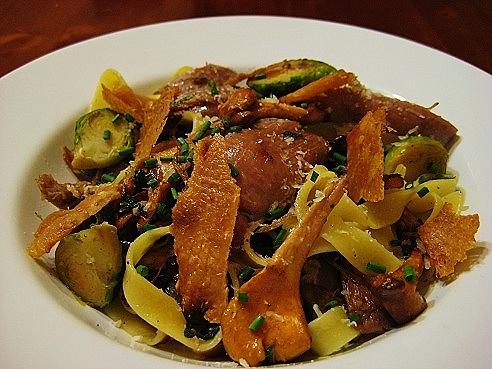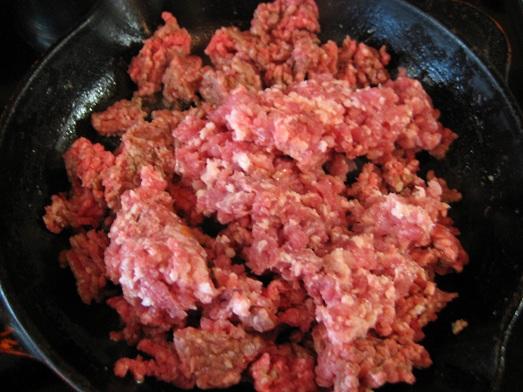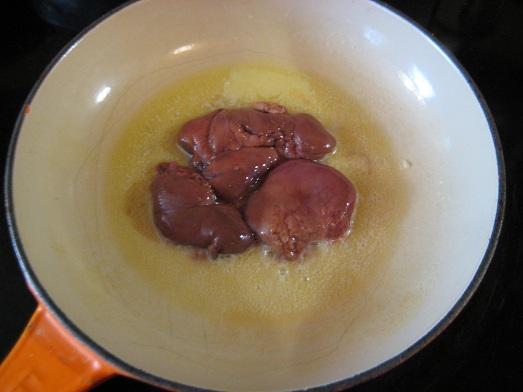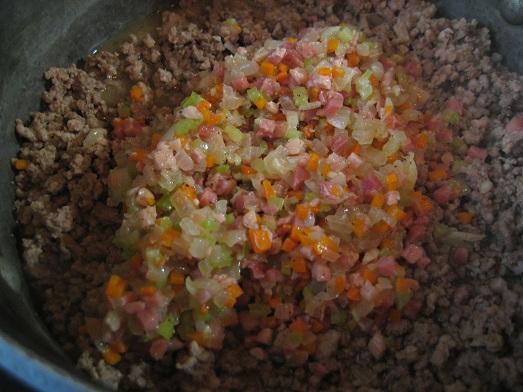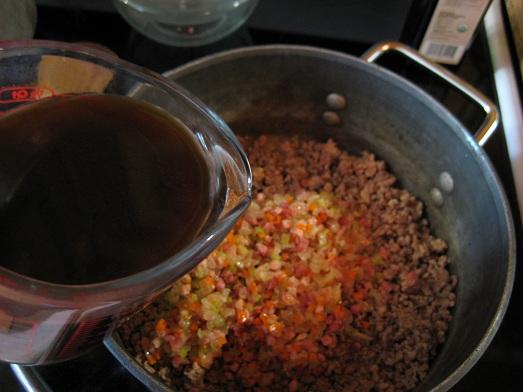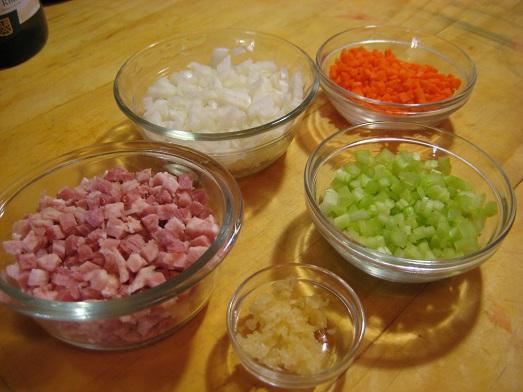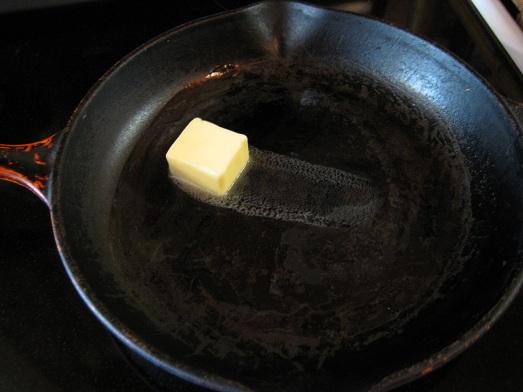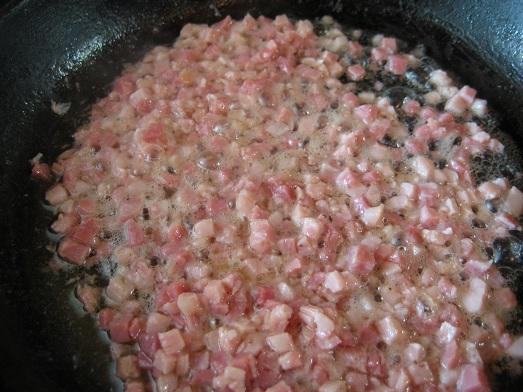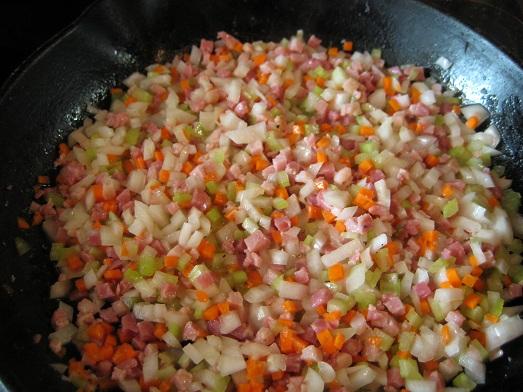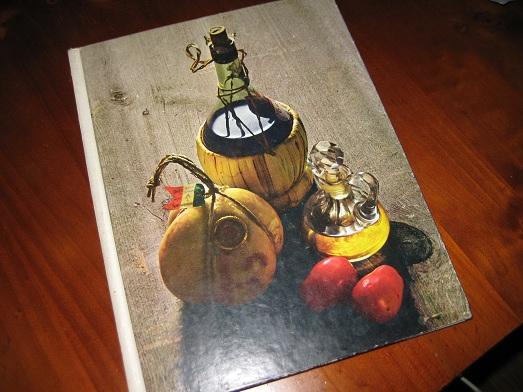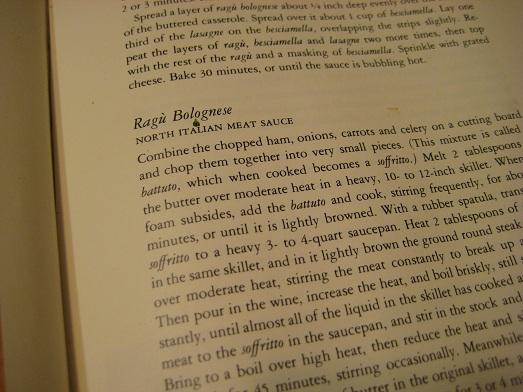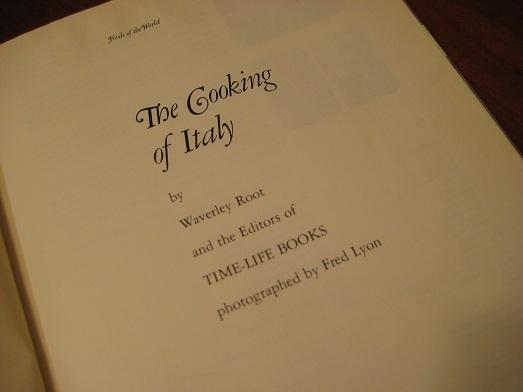-
Posts
5,035 -
Joined
-
Last visited
Content Type
Profiles
Forums
Store
Help Articles
Everything posted by David Ross
-
I've got a lot of pasta right now because I'm in the midst of the eG Cook-Off 57: Bolognese Sauce here. So in order to use up the tagliatelle I have, I did a dish with one of my favorite Fall ingredients--Duck Confit. I make homemade confit and this batch, (4 duck hindquarters), has been resting in fat for about three weeks. I gently pulled the skin off the duck and then pulled the meat off the bones. Laid the skin on a non-stick sheet and slowly roasted it in the oven at 350 until it was golden brown and crispy. Then sauteed the duck confit meat with Brussels sprouts, fresh chanterelles, garlic, a bit of chicken stock, thyme and sage. Then tossed with tagliatelle and a little dusting of parmesano-reggiano. Garnished with some chives that are still growing in the garden even though winter has arrived. The final, and best, part of the dish were the duck 'cracklings.'
-
I mentioned earlier that I really like the Bolognese episode of "In search of perfection", and I've experimented with Heston Blumenthal's recipe for the perfect "spag bol" a few times. So I decided to give it another go, this time with photos. This is an interesting recipe because it's the result of an attempt to bridge two worlds- firstly the world of the traditonal ragu alla Bolognese, and secondly the world of the English/American/Australian "spaghetti bolognese" - a tomato based pasta dish that, as Heston says, "does not exist in Italy". As I mentioned a few posts earlier, it is theorised that the westernised "spaghetti bolognese" didn't actually evolve from the traditional Bologna dish, but rather was the result of Italian migrants adding meat to their more familiar tomato sauces simply because they could afford to. If this is true, then ragu alla Bolognese and spaghetti bolognese have quite separate histories. So this recipe was developed for a TV show, and it's more complex than the traditional ragu alla Bolognese while trying to remain familiar to those who grew up with 'spag bol'. Regardless of how you think it fits into the overall Bolognese discussion, it's a very tasty dish and is one of Heston's more accessible recipes. I've veered away from the exact recipe in a few places - firstly I've used 100% beef where the original calls for a mix of ox tail and pork, and secondly I haven't used the exact herbs that Heston uses. 1) The first step, recognisably Heston, is to caramelise some onions with star anise. 2) I roughly cut up the beef and added my own variation - a few teaspoons of liquid smoke. After a short period of marination, the beef was quickly browned in a smoking hot pan, and the pan was deglazed using chardonnay. 3) The basic soffrito (heavy on the carrots) is sauteed while the chardonnay reduces in the background. 4) Then the meat, chardonnay reduction and caramelised onions are added along with 1 cup of milk, some water, and then everything is left to simmer gently for 6 hours. 5) With vine-ripened tomatos on sale, I decided to stick to the actual recipe and make the tomato sauce from scratch. Normally I'd just use 2 cans. The fresh tomatos are peeled, and the pulpy centres are scooped out and collected in a strainer. This pulp is salted and left to drain- the liquid actually has more flavour than the tomato flesh, which is chopped up and added to a saucepan that has sauteed onions in it. Out of interest, I weighed the liquid that drained from the tomato pulp and it was exactly 250grams. The pulp is discarded, the liquid is added to the tomatos. 6) So now we have two pots simmering on the stove. The large one with the meat in it, and the smaller one with the tomato sauce. 7) This is where we veer away completely from traditional, and firmly into Heston territory! The tomato sauce is pepped up with a range of ingredients that add depth and umami, none of which you'll see in an Italian recipe for Bolognese! These include sherry vinegar, fish sauce, worcestershire sauce, tobasco sauce, more star anise, cloves and ground coriander seeds. I have loads of parmesan rinds saved in the fridge so I added a small piece too. 8) These two pots are left to simmer. When the tomato sauce has simmered for two hours it has reduced to a thick consistency and tastes absolutely delicious, with loads of depth while still being instantly recognisable as a tomato sauce. 9) To finish off the tomato sauce, about 100mls of olive oil is added and the sauce is "fried" over high heat for a few minutes. The sauce is then drained and the oil saved. I actually weighed the oil to see how much of it I got back and I ended up with slightly more than the 100ml I started with! This is a rich, deep yellow, tomato flavoured oil that will be used to dress the pasta. The tomato sauce is now added to the meat and the ragu is left to simmer for an addional two hours. 10) Finally, after a total of 8 hours simmering, the dish is ready to serve. I boiled supermarket parpadelle and when it was cooked, it was drained and then tossed in some of the tomato oil. In the last few minutes, fresh herbs were stirred through the ragu (basil and thyme), along with a few dobs of butter. The ragu is seasoned with salt, pepper and a dash of sherry vinegar, and served on top of the pasta with a dash of fresh parmesan. Some more tomato oil is dotted around the plate. I've made this recipe a few times and cut different corners every time. It's safe to say that the single most defining element of the recipe is the star anise, which adds a distinctive depth that doesn't taste like aniseed or fennel. I don't think I'll bother with the fresh tomatoes again, as it's much easier to use canned and the end result is basically the same. The fresh herbs don't seem to add much either, and I'm not sure you'd notice if they weren't there at all. It's definitely not ragu alla Bolognese, and it's a step up from basic 'spag bol'. But it's delicious! Thank you for your in-depth review of a decidely uncoventional Bolognese. You've brought forward some very interesting issues that we've already lightly touched upon but we should discuss further--1) When we admit to changing the "traditional" Bolognese, whether it be the issue of milk/cream, herbs or the "tomato element," are we not honoring the Mother sauce by introducing new flavors? 2) In the restaurant kitchen it would be sacrilegious to call Chef Blumenthal's dish "Bolognese." So is a professional Chef obligated to call the dish "Ragu in the 'Bolognese' style" when it isn't traditional?
-
Yes, 1-no dairy, 1-cream, 3-milk!
-
I'll be doing a side-by-side taste comparison tommorrow--the first sauce without dairy, the second, traditional version, with cream. Don't know what my taste buds will tell me but I have an inclination I'll prefer the sauce without cream. We'll see.
-
The tickets were already rolling in. He also got in the weeds on his entrees, which needed to be out in the 12-minute range from time of ordering. Like some the contestants on Top Chef, he appeared to be really creative and had some dishes that sounded delicious, but when it came to his organizational skills and staying on top of his timing, he really fell off the cliff.
-
Back to the timing issue and how the time frame of a challenge translates into the real world. Last night I was watching "Chef Hunter" on Food Network. The episode followed Mary Sue Milliken and Susan Feniger and the staff of Border Grill in Los Angeles as they searched for a new Executive Chef. They had two candidates and both had to "audition" by cooking a dinner service in the restaurant kitchen. One poor fellow got terribly stuck in the weeds at the peak of the dinner service. With Chef Milliken and Feniger looking on, the Manager kept calling out "where's my appetizers, I need those appetizers." "The orders came in 20 minutes ago, appetizers have to go out in 8 minutes. I need appetizers, table 8." Obviously Border Grill has precise procedures and strick timing guidlines for when orders come in and have to go out, which tells me that if a Cheftestant doesn't watch the seconds ticking on the Top Chef clock, they won't be minding the clock in the restaurant kitchen. That's if they can get a job after failing the timing challenges on Top Chef.
-
That gives me more ideas--serving the meat as a separate course and the strained sauce with pasta for another course. One could even stretch the theme and do an appetizer with pancetta--sort of a Bolognese tasting menu.
-
Do you recall what the Chef's reasoning was for adding the caramelized sugar? Of course it was to add some sweet element, but was it a case of the caramel in the sugar adding a "deep" caramel, (i.e. "burnt sugar), note? That leads me to wonder if you added caramelized onions to a Bolognese. It would add somewhat of a sweet/caramel note with the added flavor of onion.
-
The next building block of the Bolognese was the meat, a mixture of ground beef, pork and chicken livers. Now mind you, I wasn't going into the cooking with the intent to duplicate a tomato-based sauce with meat--the basic tomato/pasta sauce I typically make. I realized up front that Bolognese would be a different sauce than what I was accustomed to. The chicken livers were sauteed in butter then finely minced and stirred into the meats- Once the meats were cooked down, I added the sofrito to the stew pot- Next was the "liquid" element-white wine, beef stock and tomato paste- The Bolognese cooked over a medium-low heat on the stovetop, partially covered, for the next 2 1/2 hours.
-
I started my Bolognese with the "sofrito," a mixture of diced celery, onion, carrot, garlic and diced pancetta, all sauteed in butter- The vegetables cooked over medium heat until they were soft, about 25 minutes.
-
I don't mean to single out David, of course. He is by no means alone in these feelings and practices. It's just convenient to quote his remarks because they are emblematic of something I find fairly typical among those who are used to eating Italian-American food, and who perhaps as a result have certain notions about what "Italian pasta sauce" is supposed to taste like -- which is to say: tomato-based and highly spiced for the most part (unless it completely breaks away into something like carbonara or pesto). A preference for dry herb flavor has especially become a common expectation because using lots of dried herbs has become a way for restaurants and manufacturers of jarred sauces to obscure the lower quality of their base products. And, of course, when one becomes habituated to a certain flavor profile in a certain dish, any retreat from that can seem bland (for example, Calabrians, who have an especially spicy cuisine, are known to bring little containers of dried pepper with them because non-spicy food seems bland). The result has been that many people have come to expect and desire certain flavors in an "Italian pasta sauce" that are not really the point of ragu Bolognese. This is a reason, I think, why so many are tempted to add herbs and extra tomatoes to dishes like ragu Bolognese which would otherwise seem bland to them. It's because the rich meatiness of ragu Bolognese doesn't taste like what they have come to expect out of an Italian pasta sauce. It's not dissimilar from those for whom "pizza sauce" is a highly flavored, dry-herbed cooked tomato sauce, and who find the Neapolitan base of crushed tomatoes and sea salt bland and uninteresting. This is especially interesting to me because the same people don't generally find, say, beef Stroganoff over egg noodles to be bland and in need of punching up with herbs and extra garlic. Most likely, I think, it's because we have the conception of beef Stroganoff as being rich and meaty and not highly spiced. I would argue, by the way, that tagliatelle al ragu Bolognese has more in common with beef Stroganoff on egg noodles than it does with strongly flavored tomato-based Italian pasta dishes like bucatini all'amatriciana and spaghetti alla putanesca and Italian-American red sauce. So, for me personally anyway, when we start thinking of tagliatelle al ragu Bolognese under a separate paradigm than the one we use to think about these highly spiced/flavored tomato-based pasta dishes, suddenly it doesn't seem like it needs extra tomato, spices, garlic, whatever. I don't mind a bit if we use my experiences with Bolognese to bring up arguments and discussion. In fact, I would expect just that. I think you might be right about the issue of my flavor profiles for an Italian meat sauce. I couldn't get past the fact the recipe I used didn't have any garlic, and I seemingly was craving the oregano and basil flavors. I intentionally chose dried herbs, not because of convenience but because I think in certain cooked sauces dried herbs add more flavor than fresh herbs. I'll post some photos later today. And again, thanks for the comments. It's all part of the learning curve.
-
And one could interpret Mr. Root's comments to mean that "richer ragu" employs the use of milk or cream. No?
-
I was OK with this, sort of, until I read that you omitted cream (dairy), added basil and oregano, and added Wondra. We're not in Bologna land anymore. I cooked the Bolognese over a low heat for about 4 hours so maybe if I gave it two more hours it would have thickened without the Wondra. However, the Wondra didn't add any pasty, flour taste and did help the thickening process. Without the basil and oregano it would have been pretty bland for my taste. So I recognize based on the classic that you found I stretched the boundaries, but the finished sauce was delicious. I'll try it with cream and see what I think is the taste difference in the version I prepared.
-
As heidih mentioned, I drew my recipe from the classic Time-Life "Foods of the World" series. Authored by Mr. Waverly Root, (who "first encountered Italian Cooking in Rome in 1929"), "The Cooking of Italy" was released in 1968. The "consultant" on the book was Luigi Carnacina, the "Dean of Italian Gastronomy," at the time. This is the recipe for Ragu Bolognese, "North Italian Meat Sauce" from the book, with my changes noted in italics. 1/4 pound smoked ham, coarsely chopped, (I used pancetta cut into small dice of about 1/8") 1 cup coarsely chopped onion, (I diced the onion about 1/4", as I wanted a fine texture/mouthfeel in the finished sauce) 1/4 cup coarsely chopped carrot, (I diced the carrot about 1/4" and used about 1 cup) 1/2 cup chopped celery, (Again, I diced the celery about 1/4" and used 1 cup) 4 tbsp. butter (2 Tbsp. for the vegetables and 2 Tbsp. for the chicken livers) (I added about 3 cloves of fresh garlic, minced) 2 Tbsp. olive oil 3/4lb. round steak, ground twice, (I used about 12oz. ground beef chuck) 1/4lb. lean pork, ground twice, (I used about 1/4lb. ground pork) 1/2 cup white wine 2 cups beef stock (I used about 1 1/2 cups) 2 tbsp. tomato paste (I used about 3 tbsp.) 1/2 pound chicken livers (I used 3 livers, sauteed in butter then chopped fine and added to the meat mixture) 1 cup heavy cream (omitted the cream) Pinch of ground nutmeg Salt and Pepper (I added about 2 tsp. each of dried basil and oregano) (I stirred in about 2 tbsp. of Wondra flour to thicken the sauce)
-
Not really a traditional Bolognese, but I'm curious about the Marsala. Sounds too sweet to me for a beef sauce. Do you like the flavor of the Marsala as opposed to a dry white or red wine?
-
Well, I can't agree with you more that pasta shouldn't be over-sauced, or cooked gummy, or the sauce so watery that no pasta or method will redeem it. It does seem to me that lightly-sauced pasta is more likely to end up dry than heavily-sauced, though. For me, the sauce consistency - and matching it with the pasta and the way of combining them - is very important. I've been served meat sauce pasta that's quite dry and that affects my enjoyment of it - of course it may be perfect to someone else's taste. At the other end of the scale, whilst I enjoy a bowl of ramen when I'm hungry, that noodles-in-lots-of-thin-soup isn't a natural for me at all. Give me a sauce with some body, and enough liquid to keep the dish moist. Dunno if there's Bolognese in my near future. but I'm looking forward to seeing everyone's results. I think those are good points, i.e., the thickness of Bolognese as it relates to the pasta. The characteristics of Bolognese are a thick, chunky, deep-flavored sauce--much headier than a basic tomato sauce. In my mind that calls for a sturdy pasta, not sturdy as in raw or too al dente but sturdy as in the thickness of the flat pasta. You want a bold noodle to hold up to a bold sauce and you want a balance between the two so in every bite you taste both pasta and sauce. Another element we should talk about is the cheese. Most of the Bolognese recipes I saw didn't call for any cheese to garnish the finished dish. I added only a small shower of finely grated parmesan on top of my Bolognese and pasta. Again, the bold flavors of the Bolognese should shine through, not a glump of sauce, too many noodles and a clod of cheese.
-
Sounds delicious. I loved the taste of wild Mallard when I was in my duck hunting days. I think it will add some dark, richness. If you've got enough other fat in the meat mixture, the Mallard should be fine without being dry.
-
You know me very well. That's exactly the cookbook I settled on for my Bolognese recipe. I did make a few changes however. I used pancetta instead of "smoked ham." I added some fresh garlic once the Bolognese meat and soffritto were combined and I added some dried basil and oregano. I kept the cream out and bumped up the wine by about 1/3 cup. I used white wine, but next time I'll try red for a more full-bodied Bolognese.
-
Great! We'll look forward to your Bolognese, and don't worry about any time frame. Like a great Bolognese, Cook-Offs and our conversations evolve over time. That leads to deeper discussion and in the end, we'll learn more from each other. I made my Bolognese last weekend, and I'll probably start posting some photos soon.
-
I chose not to add milk or cream to my Bolognese, but Chef Pellegrini said that cream, while not strictly traditional, is a very popular addition to Bolognese, making the finished sauce "Bolognese all Panna." (With cream). -The "tomato element." In the restaurant kitchen they use both tomato paste/puree to thicken the Bolognese and fresh, peeled tomatoes. Apparently the traditional homemade Bolognese only employs tomato paste/puree--not fresh, diced, stewed or whole tomatoes, simply puree and just enough to flavor and thicken the sauce. In the restaurant, they are making literally gallons of Bolognese which calls for them to use large quantities of both fresh tomatoes and tomato paste/puree. -Chef Pellegrini recommends fresh, flat-style pastas with Bolognese like pappardelle or tagliatelle. I could only find dried pappardelle and tagliatelle and it worked well with the finished Bolognese. But I found a third pasta, a somewhat unknown flat-shaped dried pasta, that was for me a revelation and the perfect pasta for Bolognese. You'll see it in my upcoming Cook-Off photos.
-
While searching for traditional Bolognese recipes, I turned to my friend, Chef Luciano Pellegrini for some advice. Chef Pellegrini is a James Beard Award-Winner and the Chef of Valentino at the Venetian in Las Vegas. Chef Pellegrini gave me these recommendations for Bolognese- -The main meat element should always be beef. However, game isn't out of the question. I told Chef I had some nice ground venison I got from a friend. (Harvested off a large Illinois White Tail). If I use venison, the dish becomes "Ragu di Cervo all Bolognese." -While pancetta is traditionally put into Bolognese, in the restaurant kitchens of Valentino other cured meats are regularly used. They make a variety of salumi in-house at Valentino, so it's not unusual that they will add prosciutto or butt end cuts of mortadella to the Bolognese pot.
-
The recipe has a medieval feel to me, so I usually toss in a bay leaf, and often a clove/a little cinnamon. Most of the recipes I've seen don't call for herbs or spices, and I'm not certain whether that is because it doesn't really need it, if done properly (the flavours are so depp and complex), or because it is something that has varied so much over time, it just seems wisest to leave it to the taste of the cooks. While looking through old cookbooks on Italian cuisine I found that most of the Bolognese recipes did not call for any herbs or spices, just salt and pepper. The main flavor elements in the old recipes appears to come from the main ingredients of meat and vegetables, layered with the flavor of wine and tomato. The pancetta seems to be the "unique" ingredient in the old-style Bolognese. When I start posting photos, you'll see that I add a bit of chicken liver in my Bolognese, and that added a very nice livery element to the sauce. My recipe didn't call for garlic, which I couldn't understand as I thought it probbably went into most Italian meat sauces. I added about three cloves of garlic. After hours of slow cooking, the sauce tasted like it needed something more so I added some dried basil and dried oregano which gave it a more balanced flavor.
-
Because of the reduction involved, it doesn't seem like making Bolognese sous vide would work out, while reducing just some of the ingredients is going give quite different results from reducing everything together. Might still make an interesting experiment, though. I'm not sure about gelatin, but using a thickener doesn't seem out of the question. As you'll see when I post my photos of my cooking process, my sauce was just too thin for my tastes and that was after about 1 1/2 hours of cooking. I added a slurry of about a tablespoon of Wondra Flour stirred into the Bolognese and it tightened up quite well.
-
I have to agree with you that it's an involved process. When I got everything together in the pot I thought, "gosh, that looks too soupy." My instinct told me I needed to simmer it low and slow for a few more hours than the recipe called for to both concentrate the flavors and thicken the sauce. It took time, but in the end, it had a deep, dark red hue and incredibly deep flavor.
-
The classical recipe I used was ground chuck and yes, pancetta. The recipe called for about 1 1/2 hours cooking and I stretched it to about 4 hours. I think everyone will be intrigued by the photos that I'll be posting.



